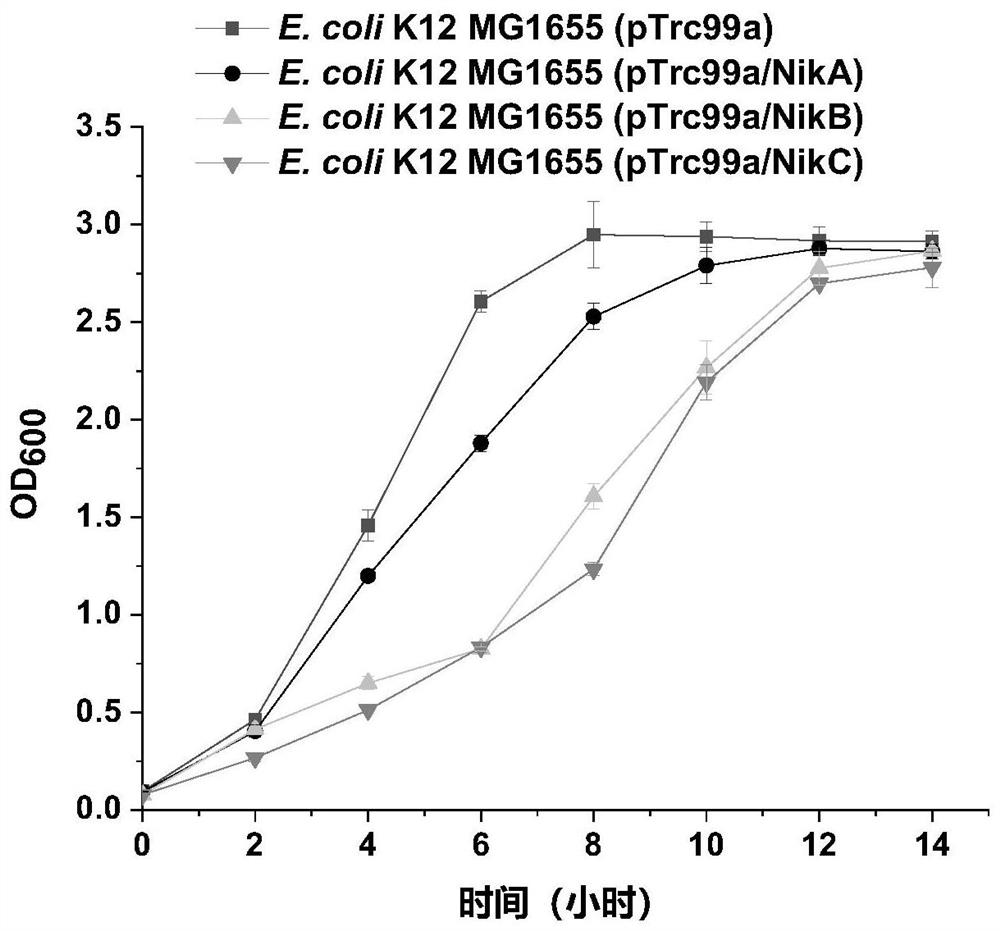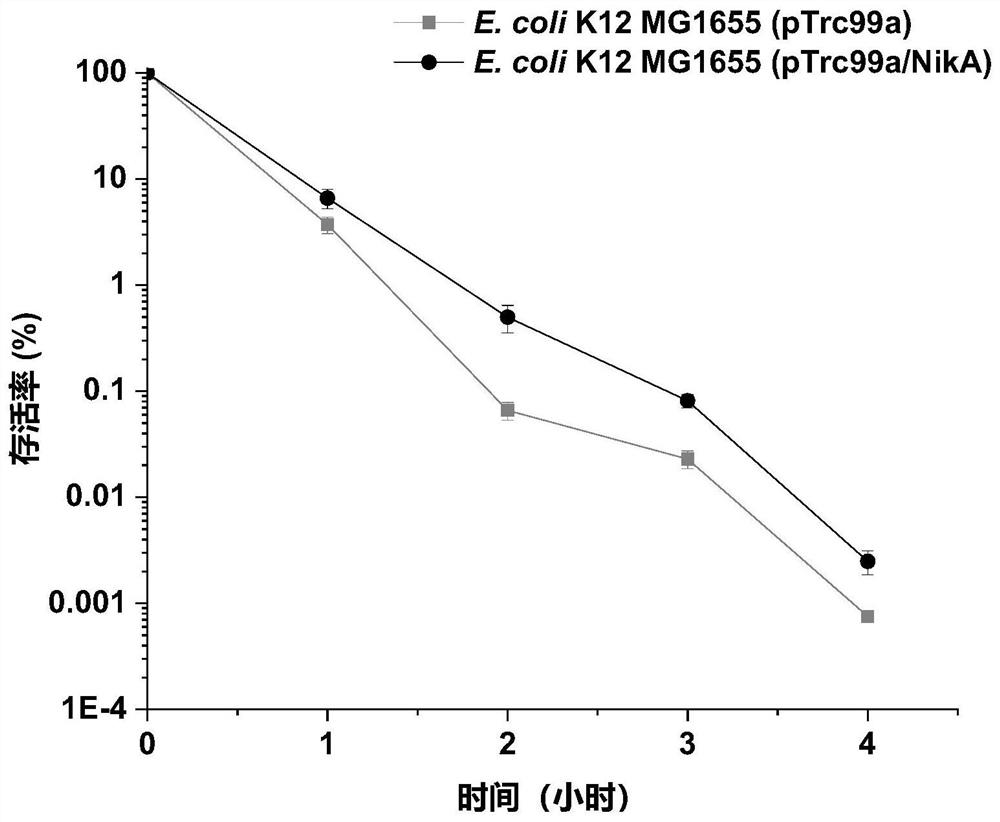A kind of Escherichia coli engineering bacterium with improved acid stress ability and its application
A technology of Escherichia coli and acid stress, applied in the field of microbial engineering, can solve the problems of easy degradation of bacteria, accumulation of by-products, low efficiency, etc., and achieve the effect of improving acid stress resistance and simple operation
- Summary
- Abstract
- Description
- Claims
- Application Information
AI Technical Summary
Problems solved by technology
Method used
Image
Examples
Embodiment 1
[0040] Example 1: Construction of recombinant strain E. coli K12 MG1655 / pTrc99a-NikA
[0041] Specific steps are as follows:
[0042] (1) Based on the nikA gene sequence in the NCBI database (the NikA gene encoding the periplasmic binding protein of nickel ion ABC transporter, involved in the ABC transport metabolic pathway of nickel ions, and regulating the binding of substrate proteins in the nickel transport system), the designs are respectively as SEQ The primers shown in ID NO.2 and SEQ ID NO.3 are pTrc99a / NikA-F, pTrc99a / NikA-R;
[0043] (2) Design the primer loops p-pTrc99a-F and loop p-pTrc99a-R as shown in SEQ ID NO.4 and SEQ ID NO.5 respectively;
[0044] (3) Using the genome of E. coli K12 MG1655 as a template, using p-pTrc99a / NikA-F, p-pTrc99a / NikA-R as primers, the gene fragment shown in SEQ ID NO.1 was obtained by PCR amplification, and PCR was obtained product;
[0045] (4) using the vector pTrc99a as the template, using the loop p-pTrc99a-F and the loop p-pT...
Embodiment 2
[0050] Example 2: Growth of recombinant strains and control strains under normal conditions
[0051] Specific steps are as follows:
[0052] (1) The strains E.coli K12 MG1655 / pTrc99a-NikA, E.coli K12MG1655 / pTrc99a-NikB, E.coli K12 MG1655 / pTrc99a-NikC and control strain E.coli K12MG1655 / pTrc99a obtained in Example 1 were inoculated respectively Activated in LB liquid medium, placed in a shaker at 37°C and cultured at 220 rpm for 12 hours to obtain seed liquid;
[0053] (2) transfer the seed liquid obtained in the above-mentioned step (1) to LB liquid medium with an inoculation amount of 2% (v / v) respectively, and place it in a 37° C. shaker for cultivation at 220 rpm; sampling every 2 hours , measure the OD value under the wavelength of 600nm, draw the growth curve (drawing the obtained growth curve such as figure 1 ).
[0054] The result is as figure 1 As shown in the growth performance test analysis, after culturing for 12 hours, the growth of the recombinant strain overe...
Embodiment 3
[0056] Example 3: Tolerance test of recombinant strain E.coli K12 MG1655 / pTrc99a-NikA under itaconic acid stress (pH 4.2)
[0057] Specific steps are as follows:
[0058] (1) The control strain E.coli K12 MG1655 / pTrc99a and the recombinant strain E.coliK12 MG1655 / pTrc99a-NikA obtained in Example 1 were respectively inoculated into LB liquid medium for activation, and cultured at 220 rpm in a shaker at 37°C 12h to obtain seed liquid;
[0059] (2) The seed liquid obtained in the above (1) was transferred to fresh LB liquid medium with an inoculum of 2% (v / v) respectively, and cultured at 220 rpm in a shaker at 37°C for 4.5 hours, and cultured to logarithmic In the middle growth stage, the OD600 at this time is 1.4-1.5, and the culture medium is obtained;
[0060] (3) Centrifuge the culture solution obtained in step (2) at 6000 rpm for 5 min, collect the cells, wash the obtained cells twice with 0.85% PBS buffer, and resuspend them in an equal volume of fresh coat Conic acid L...
PUM
 Login to View More
Login to View More Abstract
Description
Claims
Application Information
 Login to View More
Login to View More - R&D
- Intellectual Property
- Life Sciences
- Materials
- Tech Scout
- Unparalleled Data Quality
- Higher Quality Content
- 60% Fewer Hallucinations
Browse by: Latest US Patents, China's latest patents, Technical Efficacy Thesaurus, Application Domain, Technology Topic, Popular Technical Reports.
© 2025 PatSnap. All rights reserved.Legal|Privacy policy|Modern Slavery Act Transparency Statement|Sitemap|About US| Contact US: help@patsnap.com



